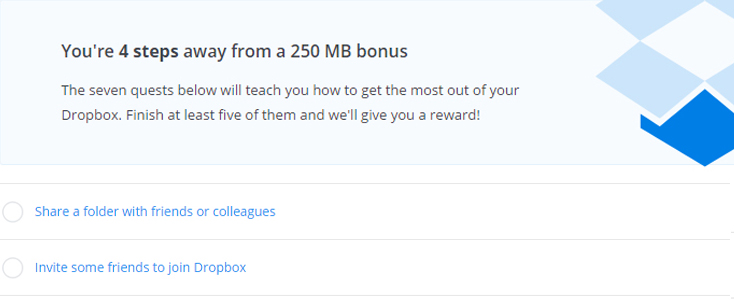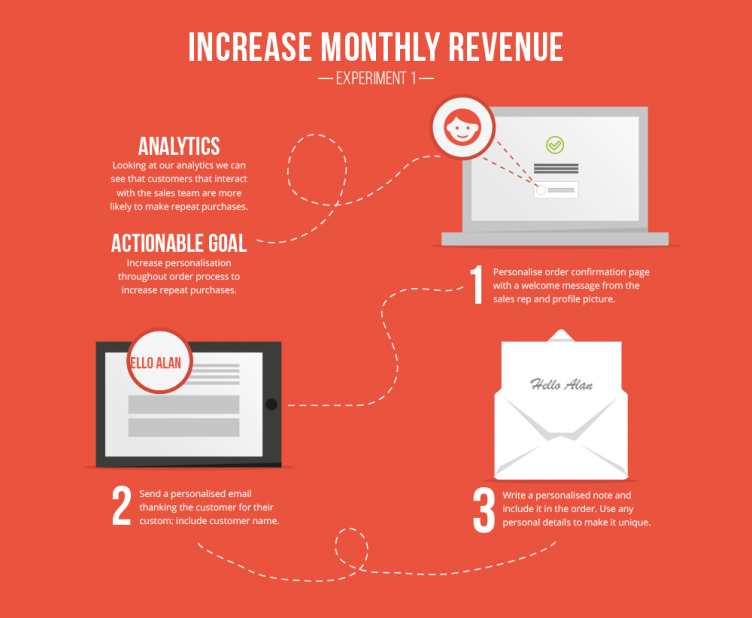I’ve being reading lots online around growth hacking and the benefits for start ups but I recently went to a great meetup down in London put on by Shopify on using growth hacking for e-commerce. I thought it would be good to share some of the insights and tips that came from it. I’ll be posting a few examples you can try with your e-commerce business over the next couple of weeks.
What is growth hacking?
After scouring the web I’ve struggled to find a clear definition but as the name suggests growth hacking is all about growing your business, whether that be multiplying your user base or increasing your transactions. Rather than using traditional marketing channels to gain more orders by bringing more customers to your store, you implement techniques and actions that help turn one order to two, two to three, three to four and so on.

A great example of growth hacking in action is Dropbox. When you first sign up there is a getting started area with useful steps for getting the most out of Dropbox. The options include ‘share Dropbox with a friend and get 500mb of free storage each’ and ‘share your Dropbox folders with friends’. Both aimed at engaging new potential users — instead of trying to market to more people themselves, they are giving new users the ability to improve their Dropbox experience by sharing the platform with potential new users. This may stem from Dropbox analysing their sign up process and seeing that users joining the site after being referred by a friend are more likely to hang around.
How to use growth hacking?
There’s a great guide to all things growth hacking by Neil Patel and Bronson Taylor here which goes in to the steps you will need to take in order to implement growth hacking techniques. I’ve summed them up below.
1. Define actionable goals
The first thing you will start with is your goal. What are you trying to acheive? This needs to be something actionable and measurable. With all e-commerce stores the overall goal is to increase revenue, whether upping the AOV (average order value), increasing the number of transactions or improving the conversion rate. But for us to be able to measure the results of an experiment we need to refine this goal.
Think about what smaller goal will help achieve the overall goal. Increasing the number of monthly orders will increase your overall revenue — but that’s still too broad. How do we increase the number of monthly orders? After looking at our analytics we may see that customers who have spoken to a sales representative are twice more likely to make a repeat purchase. We can then use this information to create an experiment aimed at increasing repeat purchases which in turn will increase our monthly revenue. That then becomes our actionable goal: Increase sales representative interactions to double repeat purchases.
2. Implement analytics
If you aren’t able to analyse results how will you know something is or isn’t working? Using the above example you would need to make sure you can:
- Track when a repeat purchase has occurred
- See what stage of the experiment a customer has dropped out — is it a certain page, an email or have they not even started?
- See whether the first purchase was of a certain size and whether the repeat purchase was of greater or lower value
- See when a sales representative has interacted with a customer
- See what that interaction was and what channel was used — email, phone, in person.
Analytics give us the information to make informed decisions, we may see that a certain experiment is working, we may also see that we need to refine our goals. From the data we may find that repeat purchases only increase when sales representatives speak to a customer on the phone so we can work that in to the experiment.
3. Leverage your existing strengths
For each goal we want to achieve there are lots of different experiments we could try. Leveraging our strengths allows us to try them in an order that uses the least effort, energy and cost.
Again using the example above we can setup an automated email that introduces the customer to the sales representative straight after the order has been complete with a personalised thank you message, followed up by a call. This may take a day to implement.
Another option could be that each order is delivered by the customers sales representative to add an in person interaction, this could require a sales representative to be out of the office for a couple of hours at a time and you’re getting 10 orders a day which would leave no time to do anything else without getting in more staff, which would add extra costs.
The obvious choice is to spend the day implementing the automated but personalised email, tracking the results and if it doesn’t work we move to the next one.
4. Execute the experiment
When you’re ready to run your experiment it’s easy to get excited and jump in but it’s important to document a few things first. Ask yourself:
- What do you think will happen?
- Why do you think that?
- Will this make you reach your goal?
- If not will it get you part way there?
This will give you something to reflect on and if you are wrong about your assumptions you can discuss why and use this for the next experiment.
It’s important to make sure you have the resource available to perform the experiment — do you have enough stock to last if this works, have you got enough staff to fulfill orders and have you set yourself enough time to implement the experiment properly?
5. Analyse, optimise and repeat
Experiments are made to be refined and repeated. Not all experiments are successful and it’s important to stay positive when the experiments you thought were going to revolutionalise your business don’t work. Don’t get down, think of how we can improve and try again or move on to the next idea.
When running an experiment be sure to try different versions with A/B testing. You may send one email with an image of the sales representative and one without, change content and subject lines between emails to see which converts better.
Make sure you have a control group. This will help measure results against the norm — you can make sure that results are specific to your experiment and not due to something outside of your control. When sending emails only send them to 80% of your customer base leaving 20% untouched. If we see that this is working then we can start to include all customers.
After completing each experiment refine it, think of ways to improve it and run it again. Keep running the experiment until you think it has reached its maximum potential or you are no longer able to think of ways to improve it.
Conclusion
Growth hacking is different to traditional marketing channels, you’re not going out and doing a hard sell to a potential customer. You’re taking orders that have already happened and multiplying them. Repeat purchases and sharing become the driving force of your efforts. You don’t need to go out and find a new customer to engage with your brand, you already have one that trusts you enough to purchase from you so think about how you will get them to do it again — half the battles has been won.
We as the e-commerce store will always struggle to gain the same level of trust that friends, co-workers and family have between each other, so leverage that trust and make it easy to share as much as possible and entice with promotions, useful content and anything that makes the experience for everyone involved better.
Make every experience personal and unique to the customer (even if it’s not). It’s becoming increasingly easier to automate personalised experiences and carry that personalisation across multiple channels — let customers know you care about them and that their purchase is important to you. Go the extra mile and add a WOW factor to every order.
Takeaways
- Set actionable goals
- Use analytics to track all experiments
- Experiments are never finished. Analyse, optimise and repeat
- Use control groups to track results against unforeseen circumstances
- Make all communications and interactions personal to the customer
- Get existing customers to share with friends, family and co-workers
- Push existing customers to make repeat purchases
Let us know what growth hacking techniques you’re using with your e-commerce business. Don’t forget to sign up to our newsletter and stay up to date with all the latest posts on our blog. Follow me on twitter @thorp88.

